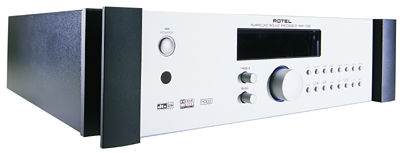Rotel RSP-1066 surround preamp-processor

Rotel has been at this game longer than most; I reviewed their RSP-960 (Dolby Pro Logic only, no video switching) in the very first issue of SGHT (April 1995, Vol.1 No.1). Rotel's back catalog of pre-pros includes five models, and that's not counting various add-on Dolby Digital/DTS decoders. The last Rotel pre-pro I reviewed was the RSP-976 (July 2001), and I thought it was an outstanding product at its $1199 price. The RSP-976 has now been replaced by the RSP-1066 (a model number that will be appreciated by students of British history), which has all the features of the RSP-976, plus:
• two rear-center outputs
• a second subwoofer output
• adjustable subwoofer crossover frequency (40-120Hz in 20Hz increments)
• Cinema EQ treble re-equalization
• Dolby Digital Surround EX
• Dolby Pro Logic II
• DTS-ES Matrix and DTS-ES Discrete, both 6.1-channel
• DTS Neo:6 surround modes for deriving surround channels for 5.1-, 6.1-, or 7.1-channel systems from 2-channel stereo or matrix-surround recordings
• automatic decoding of digital signals from MP3 players
• Rotel XS automatic decoding from any digital multichannel signal in 6.1- and 7.1-channel systems
• automatic decoding of HDCD discs
• upgradeable microprocessor software to accommodate future upgrades
That's a lot of added features for a price increase of only $300. Assuming that adding them didn't compromise basic sound quality, it seemed that Rotel might have come up with another winner.
Setup
Like the RSP-976, the RSP-1066 must be set up with an onscreen display, which is available only from the composite or S-video outputs, not component video. The RSP-1066 has the by-now de rigueur facility to assign specific physical inputs (e.g., coaxial digital) to each input source, with auto-sensing that selects digital over analog inputs unless the default for that source is set to analog. A default surround mode can be set for each input, but many sources (e.g., DVDs with Dolby Digital/DTS soundtracks) automatically override the default surround settings and also prevent the manual selection of alternative surround modes. Early Dolby Surround EX-encoded discs did not have the requisite flag, so for these you have to select Dolby Surround EX manually.
The speaker-setup menu has the usual choice of Large/Small, Subwoofer Yes/No, Center Delay, and Surround Delay settings, and, optionally, one or two Center Back speakers with associated delays. Subwoofer levels can be set up independently for each mode (e.g., Dolby, DTS), and the Max setting directs all low frequencies to the subwoofer(s) from all speakers, including ones designated Large. As noted above, the subwoofer crossover frequency is now variable; in my system, the THX standard 80Hz worked best, but those with more-nearly-full-range speakers will appreciate the inclusion of lower crossover frequencies. Unlike some more expensive surround pre-pros (e.g., the Anthem AVM 20, which I reviewed in the May 2002 issue), the RSP-1066 does not have a bass limiter circuit, so you'll have to rely on the bass overload circuitry in your subwoofer (if it has it, as many do), or else keep an ear out for symptoms of distress from the sub at high levels.
The RSP-1066 has the same RR-969 remote control as the RSP-976; I didn't like it very much before, and I don't care for it now. Yes, it can control up to nine other components in addition to the RSP-1066, and it has a macro learning facility, but I'd gladly trade all that for a simpler, more ergonomic layout, with frequently used controls like input selection, filter, and surround mode easily accessible rather than hidden under a sliding panel. The RR-969 has 41 buttons that can be illuminated, but only 12 of these involve control of the RSP-1066's functions.
Setting up the RSP-1066 was pretty straightforward; the owner's manual, like that of the RSP-976, provided clear instructions. The test tone is sequenced manually, which I prefer to the type of automatic sequencing that makes you wait for the tone to come around to a given speaker. Delays are set by first measuring the distance of each speaker to the listener, calculating the difference between the greatest speaker-listener distance and each of the other speaker-listener distances, and then adding 1 millisecond of delay for each foot that the speaker is closer than the farthest speaker. This is not as straightforward as simply entering the distances, but it gets the job done.
In my review of the RSP-976, I mentioned a problem that I thought may have represented a sample fault or an idiosyncratic system interaction: a distinct, audible click whenever the digital datastream was interrupted, such as when changing tracks on a CD or chapters on a DVD. Whatever the case with the RSP-976, I'm pleased to report that the RSP-1066 was free of this problem, with no click evident under these conditions even when I tried to deliberately induce it.
The RSP-1066 had one operational quirk: When Mute is engaged, it can be disengaged only by pressing the Mute button again, not by turning up the volume. I'm told that this has been remedied in current production; in fact, a software download is available that will correct it. I didn't find having to use the Mute button all that troublesome, so I didn't bother with the download, but it's good to know that issues like this can be handled via software.
- Log in or register to post comments




















































